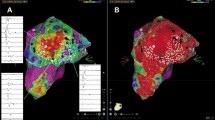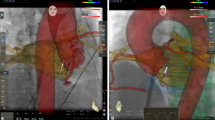Abstract
Background
With CARTO HD COLORING, a new enhanced software-based map visualization is available to highlight among others potential areas of conduction block in complex arrhythmias (extended early meets late (EEML)). The ideal settings of thresholds are still unclear and are examined here by studying 12 left atrial arrhythmias.
Methods
Ten patients with left atrial tachycardia underwent high-density activation mapping of the left atrium. Areas of local conduction block were visualized with different extended early meets late (EEML) thresholds (75/25%; 80/20%; 85/15%; 90/10%) and compared with ripple maps for verification.
Results
Settings of 80/20% or 85/15% were more accurate than the default settings of 75/25% in displaying the actual amount of conduction block as assessed by ripple maps.
Conclusion
HD COLORING leads to further insights into complex tachycardias through a new Voxel Map Surface Concept and color-based visualization of local conduction block. It can be assumed that individual adaption of extended early meets late (EEML) thresholds should be applied for a more accurate visualization of local conduction block.






Similar content being viewed by others
References
Del Carpio Munoz F, Buescher TL, Asirvatham SJ. Three-dimensional mapping of cardiac arrhythmias: what do the colors really mean? Circ Arrhythm Electrophysiol. 2010;3(6):e6–11.
Zar L, Katz NS, Cohen B, inventor; Biosense Webster (Israel) LTD, Yokneam (IL), assignee. High Definition Coloring of Heart Chambers. United States patent US20170103570A1. 2017 August 3, 2017.
Zar L, Katz NS, Cohen B, inventor; Biosense Webster (Israel) LTD., Yokneam (IL), assignee. Voxelisation of a Mesh. United States patent US20170103570A1. 2017.
Olshansky B, Okumura K, Henthorn RW, Waldo AL. Characterization of double potentials in human atrial flutter: studies during transient entrainment. J Am Coll Cardiol. 1990;15(4):833–41.
Morgan JM, Haywood G, Schirdewan A, Brugada P, Geelen P, Meyerfeldt U, et al. “Double” potentials define linear lesion conduction block using a novel mapping/linear lesion ablation catheter. J Cardiovasc Electrophysiol. 2003;14(3):236–42.
Tada H, Oral H, Sticherling C, Chough SP, Baker RL, Wasmer K, et al. Double potentials along the ablation line as a guide to radiofrequency ablation of typical atrial flutter. J Am Coll Cardiol. 2001;38(3):750–5.
Koa-Wing M, Nakagawa H, Luther V, Jamil-Copley S, Linton N, Sandler B, et al. A diagnostic algorithm to optimize data collection and interpretation of ripple maps in atrial tachycardias. Int J Cardiol. 2015;199:391–400.
Linton NW, Koa-Wing M, Francis DP, Kojodjojo P, Lim PB, Salukhe TV, et al. Cardiac ripple mapping: a novel three-dimensional visualization method for use with electroanatomic mapping of cardiac arrhythmias. Heart Rhythm. 2009;6(12):1754–62.
Katritsis G, Luther V, Kanagaratnam P, Linton NW. Arrhythmia mechanisms revealed by ripple mapping. Arrhythm Electrophysiol Rev. 2018;7(4):261–4.
De Ponti R, Verlato R, Bertaglia E, Del Greco M, Fusco A, Bottoni N, et al. Treatment of macro-re-entrant atrial tachycardia based on electroanatomic mapping: identification and ablation of the mid-diastolic isthmus. Europace. 2007;9(7):449–57.
Author information
Authors and Affiliations
Corresponding author
Ethics declarations
Conflict of interest
L.I. has received lecture and consultant honoraria from Biosense Webster. M.B. has received consultant honoraria from Biosense Webster. R.W., S.G., K.K., and G.R. have nothing to declare. Regarding this article, none of the authors states any conflict of interest.
Additional information
This article is original, with no portion under simultaneous consideration for publication elsewhere or previously published. All authors have read and approved the submission.
Publisher’s note
Springer Nature remains neutral with regard to jurisdictional claims in published maps and institutional affiliations.
Rights and permissions
About this article
Cite this article
Iden, L., Weinert, R., Groschke, S. et al. First experience and validation of the extended early meets late (EEML) tool as part of the novel CARTO software HD COLORING. J Interv Card Electrophysiol 60, 279–285 (2021). https://doi.org/10.1007/s10840-020-00726-w
Received:
Accepted:
Published:
Issue Date:
DOI: https://doi.org/10.1007/s10840-020-00726-w




